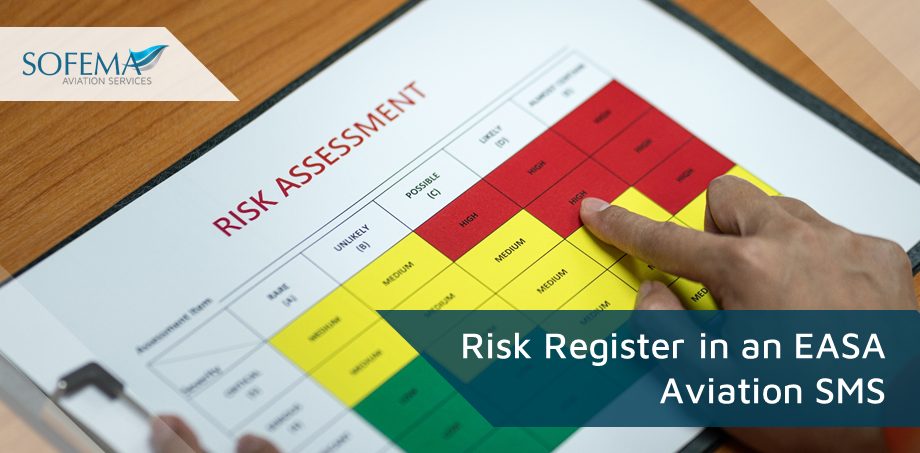Sofema Aviation Services (SAS) www.sassofia.com looks at the Risk Register Process which should sit at the Heart of the Organizations SMS
Introduction – EASA Risk-Based Oversight & the role of the risk register
Aviation safety management system (SMS) risk registers are used to identify and manage potential hazards and risks associated with aviation operations.
The risk register is an essential tool to manage risks and ensure aviation safety. By using a risk-based approach to oversight, Organizations can allocate resources more efficiently and effectively, focus on areas of highest risk, and improve the overall safety of the aviation industry
The risk register typically includes a list of identified hazards, their potential consequences, and the likelihood of those consequences occurring. Risks are typically assessed using a risk matrix or similar tool, which allows the organization to prioritize risks based on their severity and likelihood.
The Risk-Based Oversight (RBO) framework is used by EASA to identify and mitigate risks in the aviation industry.
- The role of the risk register is to support this process by providing a centralized and standardized tool to manage and analyze risks.
o A risk register is a tool used to record and analyze risks, their likelihood and potential impact, and the controls in place to manage them.
o The risk register is used to identify, assess, and prioritize risks, and to determine appropriate risk responses and control measures.
o The risk register also helps to ensure that risks are managed consistently across the aviation industry and that risk management processes are transparent and auditable.
Considering the Role of the Risk Register in the Context of Risk-Based Oversight (RBO)
In the context of EASA’s RBO framework, the risk register is used to:
- Identify and assess risks associated with specific aviation activities, such as aircraft maintenance or air traffic control.
- Prioritize risks based on their potential impact on aviation safety and the likelihood of occurrence.
- Determine appropriate risk responses and control measures to mitigate or manage risks.
- Monitor and review risk management processes and controls to ensure they remain effective over time.
Optimization of the Risk Register
Optimizing an aviation safety management system (SMS) risk register involves reviewing and refining the list of identified hazards and associated risks.
This process helps to prioritize safety issues, allocate resources efficiently, and improve the overall safety performance of an organization.
By following these steps, an organization can optimize its aviation safety management system risk register and improve its overall safety performance.
- Review the existing risk register:
o Start by reviewing the existing risk register to identify any gaps, redundancies, or inaccuracies.
o It is essential to ensure that all identified hazards and associated risks are up-to-date and relevant.
- Evaluate risk assessment methodologies:
o Evaluate the risk assessment methodologies that are being used to assess the identified hazards and risks.
o Consider whether the current methodologies are appropriate for the organization’s operations and whether they are being applied consistently and effectively.
- Refine risk scoring criteria:
o Refine the risk scoring criteria to ensure that the scoring system accurately reflects the likelihood and severity of each identified risk.
o Ensure that the criteria are specific, measurable, and objective.
- Prioritize risks:
o Prioritize risks based on their likelihood and severity. Consider the potential consequences of each risk and the resources required to address it.
o This will help to allocate resources more effectively and prioritize risk mitigation efforts.
- Monitor and review:
o Continuously monitor and review the risk register to ensure that it remains up-to-date and relevant.
o Regularly review the risk assessment methodologies, risk scoring criteria, and risk prioritization to ensure that they are still appropriate for the organization’s operations.
- Involve stakeholders:
o Involve relevant stakeholders in the risk register optimization process.
o This includes employees, managers, and external stakeholders such as regulatory agencies and customers.
o Their input can help to identify additional hazards and risks and ensure that the risk register is comprehensive.
Risk Register – Shortfalls
It is important for aviation organizations to regularly review their SMS risk registers to ensure that they accurately reflect potential hazards and risks associated with their operations, and that effective risk management strategies are in place to address these risks. Consider the following aspects as potential areas of shortfall:
- Incomplete risk assessments:
o Risk registers may not accurately capture all potential hazards and risks associated with aviation operations.
o This can occur if the risk assessment process is not comprehensive enough, or if there are gaps in the data used to identify risks.
- Lack of prioritization:
o Risk registers may not prioritize risks according to their severity or likelihood of occurrence, which can lead to a misallocation of resources and ineffective risk management strategies.
- Insufficient risk mitigation strategies:
o Risk registers may not include adequate risk mitigation strategies or contingency plans to address potential hazards and risks. This can leave organizations vulnerable to accidents and incidents.
- Poor communication and reporting:
o Risk registers may not be communicated effectively to all stakeholders, or there may be insufficient reporting mechanisms in place to identify emerging risks in real-time.
- Inadequate monitoring and review:
o Risk registers may not be regularly reviewed and updated to reflect changes in aviation operations and new risks that may arise.
Next Steps
Follow this link to our Library to find & Download related documents for Free.
Sofema Aviation Services (www.sassofia.com) and Sofema Online (www.sofemaonline.com) provide Classroom, Webinar & Online Training of EASA Regulatory Compliant and Vocational Training Courses, for questions please email team@sassofia.com
Tags:
Aviation Operations, Aviation Safety Management System, EASA Regulatory Compliant and Vocational Training, Library, potential hazards, RBO framework, risk management strategies., Risk Matrix, Risk Mitigation, Risk Register, Risk Register – Shortfalls, Risk Register Process, Risk-Based Oversight (RBO), SAS blogs, SMS




